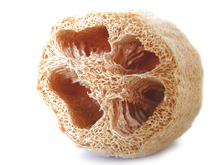Luffa aegyptiaca
| Luffa aegyptiaca | |
|---|---|

| |
| Egyptian luffa fruit | |
| Scientific classification | |
| Kingdom: | |
| (unranked): | |
| (unranked): | |
| (unranked): | |
| Order: | |
| Family: | |
| Genus: | |
| Species: | L. aegyptiaca
|
| Binomial name | |
| Luffa aegyptiaca | |
| Synonyms[1] | |

Luffa aegyptiaca , sponge gourd,[2] Egyptian cucumber, and also known as Vietnamese luffa, for Vietnam is its native habitat (Vietnamese: mướp hương), is a species of Luffa grown for its fruit. The plant is an annual vine, native to South Asia and Southeast Asia.It is known as Awmpawng in Mizo and Bhûl (ভোল) in Assamese.
Etymology
The botanical specific epithet "aegyptiaca" was given to this plant in the 16th century when European botanists were introduced to the plant from its cultivation in Egypt. In the European botanical literature, the plant was first described by Johann Veslingius in 1638, who named it "Egyptian cucumber". Veslingius also introduced the name "Luffa".[3]
Description and cultivation
The about-30-cm-long fruit resembles a cucumber in shape and size. Owing to its striking yellow flowers, Luffa aegyptiaca is occasionally grown as an ornamental.
Luffa aegyptiaca is best grown with a trellis support.[4] It requires lots of heat and lots of water to thrive.
Uses
The young fruit is eaten as a vegetable and is commonly grown for that purpose in tropical Asia. Unlike the young fruit, the fully ripened fruit is strongly fibrous and inedible, and is used to make scrubbing bath sponges. Due to the use as a scrubbing sponge, it is also known by the common names dishrag gourd, rag gourd, sponge gourd, and vegetable-sponge.[1] It is also called smooth luffa to distinguish it from the ridged luffa (Luffa acutangula), which is used for the same purposes.[1]
 |
 |
| Nutritional value per 100 g (3.5 oz) | |||||||||||||||||||||||||||||||||||||||||||||
|---|---|---|---|---|---|---|---|---|---|---|---|---|---|---|---|---|---|---|---|---|---|---|---|---|---|---|---|---|---|---|---|---|---|---|---|---|---|---|---|---|---|---|---|---|---|
| Energy | 56 kJ (13 kcal) | ||||||||||||||||||||||||||||||||||||||||||||
14.34 g | |||||||||||||||||||||||||||||||||||||||||||||
| Sugars | 5.17 g | ||||||||||||||||||||||||||||||||||||||||||||
| Dietary fiber | 2.9 g | ||||||||||||||||||||||||||||||||||||||||||||
0.34 g | |||||||||||||||||||||||||||||||||||||||||||||
0.66 g | |||||||||||||||||||||||||||||||||||||||||||||
| |||||||||||||||||||||||||||||||||||||||||||||
| †Percentages estimated using US recommendations for adults,[5] except for potassium, which is estimated based on expert recommendation from the National Academies.[6] | |||||||||||||||||||||||||||||||||||||||||||||
References
- ^ a b c d GRIN (May 10, 2000). "Luffa aegyptiaca information from NPGS/GRIN". Taxonomy for Plants.
- ^ USDA, NRCS (n.d.). "Luffa aegyptiaca". The PLANTS Database (plants.usda.gov). Greensboro, North Carolina: National Plant Data Team. Retrieved 23 June 2015.
- ^ Johann Veslingius, De Plantis Aegyptiis, 1638. p. 48 (in Latin)
- ^ A Legacy of Luffa, by Elizabeth Harwick, who grows Luffa aegyptiaca successfully in South Carolina.
- ^ United States Food and Drug Administration (2024). "Daily Value on the Nutrition and Supplement Facts Labels". FDA. Archived from the original on 2024-03-27. Retrieved 2024-03-28.
- ^ National Academies of Sciences, Engineering, and Medicine; Health and Medicine Division; Food and Nutrition Board; Committee to Review the Dietary Reference Intakes for Sodium and Potassium (2019). Oria, Maria; Harrison, Meghan; Stallings, Virginia A. (eds.). Dietary Reference Intakes for Sodium and Potassium. The National Academies Collection: Reports funded by National Institutes of Health. Washington, DC: National Academies Press (US). ISBN 978-0-309-48834-1. PMID 30844154. Archived from the original on 2024-05-09. Retrieved 2024-06-21.
External links
- Luffa aegyptiaca at Floridata
- Multilingual taxonomic information at the University of Melbourne
- Luffa.info: Info on growing and using Luffa egyptiaca as a scrubbing sponge]
- Dressler, S.; Schmidt, M. & Zizka, G. (2014). "Luffa aegyptiaca". African plants – a Photo Guide. Frankfurt/Main: Forschungsinstitut Senckenberg.
